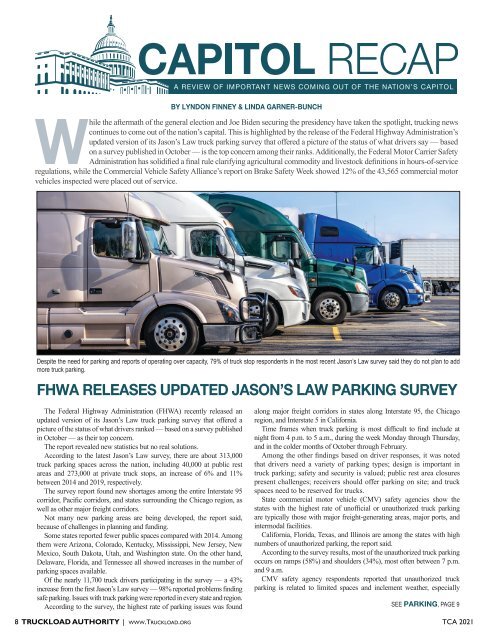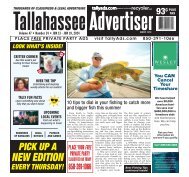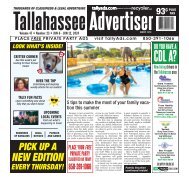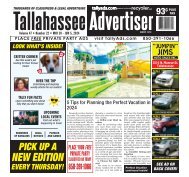TLA46_AllPages
Create successful ePaper yourself
Turn your PDF publications into a flip-book with our unique Google optimized e-Paper software.
BY LYNDON FINNEY & LINDA GARNER-BUNCH<br />
While the aftermath of the general election and Joe Biden securing the presidency have taken the spotlight, trucking news<br />
continues to come out of the nation’s capital. This is highlighted by the release of the Federal Highway Administration’s<br />
updated version of its Jason’s Law truck parking survey that offered a picture of the status of what drivers say — based<br />
on a survey published in October — is the top concern among their ranks. Additionally, the Federal Motor Carrier Safety<br />
Administration has solidified a final rule clarifying agricultural commodity and livestock definitions in hours-of-service<br />
regulations, while the Commercial Vehicle Safety Alliance’s report on Brake Safety Week showed 12% of the 43,565 commercial motor<br />
vehicles inspected were placed out of service.<br />
Despite the need for parking and reports of operating over capacity, 79% of truck stop respondents in the most recent Jason’s Law survey said they do not plan to add<br />
more truck parking.<br />
FHWA RELEASES UPDATED JASON’S LAW PARKING SURVEY<br />
The Federal Highway Administration (FHWA) recently released an<br />
updated version of its Jason’s Law truck parking survey that offered a<br />
picture of the status of what drivers ranked — based on a survey published<br />
in October — as their top concern.<br />
The report revealed new statistics but no real solutions.<br />
According to the latest Jason’s Law survey, there are about 313,000<br />
truck parking spaces across the nation, including 40,000 at public rest<br />
areas and 273,000 at private truck stops, an increase of 6% and 11%<br />
between 2014 and 2019, respectively.<br />
The survey report found new shortages among the entire Interstate 95<br />
corridor, Pacific corridors, and states surrounding the Chicago region, as<br />
well as other major freight corridors.<br />
Not many new parking areas are being developed, the report said,<br />
because of challenges in planning and funding.<br />
Some states reported fewer public spaces compared with 2014. Among<br />
them were Arizona, Colorado, Kentucky, Mississippi, New Jersey, New<br />
Mexico, South Dakota, Utah, and Washington state. On the other hand,<br />
Delaware, Florida, and Tennessee all showed increases in the number of<br />
parking spaces available.<br />
Of the nearly 11,700 truck drivers participating in the survey — a 43%<br />
increase from the first Jason’s Law survey — 98% reported problems finding<br />
safe parking. Issues with truck parking were reported in every state and region.<br />
According to the survey, the highest rate of parking issues was found<br />
along major freight corridors in states along Interstate 95, the Chicago<br />
region, and Interstate 5 in California.<br />
Time frames when truck parking is most difficult to find include at<br />
night from 4 p.m. to 5 a.m., during the week Monday through Thursday,<br />
and in the colder months of October through February.<br />
Among the other findings based on driver responses, it was noted<br />
that drivers need a variety of parking types; design is important in<br />
truck parking; safety and security is valued; public rest area closures<br />
present challenges; receivers should offer parking on site; and truck<br />
spaces need to be reserved for trucks.<br />
State commercial motor vehicle (CMV) safety agencies show the<br />
states with the highest rate of unofficial or unauthorized truck parking<br />
are typically those with major freight-generating areas, major ports, and<br />
intermodal facilities.<br />
California, Florida, Texas, and Illinois are among the states with high<br />
numbers of unauthorized parking, the report said.<br />
According to the survey results, most of the unauthorized truck parking<br />
occurs on ramps (58%) and shoulders (34%), most often between 7 p.m.<br />
and 9 a.m.<br />
CMV safety agency respondents reported that unauthorized truck<br />
parking is related to limited spaces and inclement weather, especially<br />
SEE PARKING, PAGE 9<br />
8 TRUCKLOAD AUTHORITY | www.Truckload.org TCA 2021

















